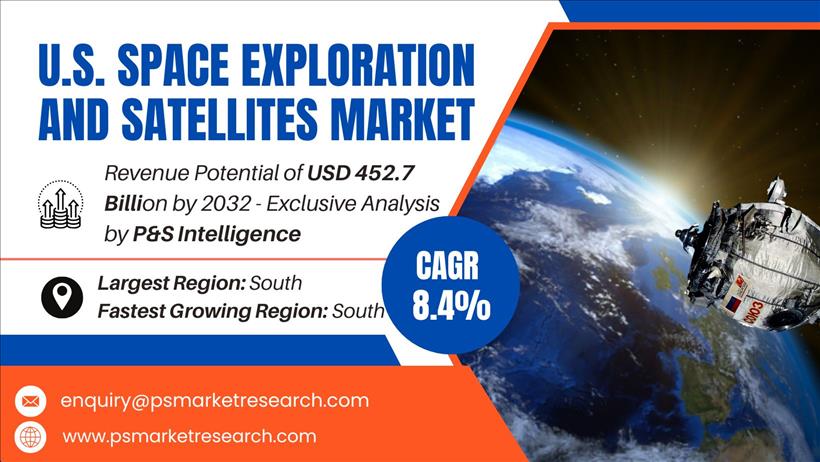Science
U.S. Space Market Set to Surge to $452.7 Billion by 2032

The U.S. space exploration and satellites market is on track to reach a remarkable value of USD 452.7 billion by 2032, up from USD 240.1 billion in 2024. This significant growth is fueled by increased government investments, technological advancements, and the expanding commercialization of space activities. According to a recent market study by P&S Intelligence, the market is projected to grow at a compound annual growth rate (CAGR) of 8.4% from 2025 to 2032.
A key driver of this expansion is the rising demand for satellite-based services across various sectors, including communication, navigation, and defense. The U.S. government has ramped up funding for space defense programs, which, coupled with strategic collaborations in space diplomacy, is further accelerating market growth. Innovations, such as reusable rocket technology and the development of micro, nano, and modular satellites, are also making space more accessible for private enterprises.
Market Dynamics and Key Insights
The low Earth orbit (LEO) segment dominated the market in 2024, accounting for over 55% of market share. This segment benefits from the growing demand for broadband connectivity, earth observation, and scientific missions. Notable companies like SpaceX and Amazon’s Kuiper Systems are leading the way in deploying large constellations of LEO satellites, enhancing global connectivity.
Meanwhile, the medium Earth orbit (MEO) segment is expected to experience the fastest growth due to the increasing utilization of MEO satellites in GPS and broadband applications. Their ability to provide a balance of coverage and signal strength makes them ideal for both military and commercial uses.
In terms of launch vehicles, heavy-lift options held a substantial 40% market share in 2024, largely due to their capacity to transport large payloads necessary for deep-space missions and satellite constellations. A prime example is the upcoming launch of 27 Kuiper satellites aboard the ULA Atlas V 551 rocket in April 2025.
The market for small-lift launch vehicles is also on the rise, with expectations for the highest CAGR driven by the increasing popularity of CubeSats and microsatellites for various commercial and scientific missions.
Satellites themselves represented the largest payload type in 2024, making up 75% of the market due to their essential functions in communication and navigation. Companies such as Amazon and OneWeb are making significant strides in their satellite network deployments.
Sectoral Insights and Government Spending
The communication segment led the market with a 45% share, boosted by the rising demand for high-speed internet and the integration of 5G technologies. Initiatives like AST SpaceMobile’s Direct-to-Device services and T-Mobile’s collaboration with SpaceX are noteworthy examples of this trend.
The navigation segment is also poised for rapid expansion, driven by an increasing reliance on GPS and GNSS technologies for autonomous vehicles, precision agriculture, urban planning, and smart city initiatives.
Government investment remains a cornerstone of this market, accounting for 55% of end-use share in 2024. Agencies such as NASA, the Department of Defense, and the National Reconnaissance Office are driving this trend, with NASA requesting USD 18.8 billion for FY2026, earmarked for lunar and Mars missions.
Furthermore, the commercial sector is expected to grow the fastest, reflecting an increase in private sector participation in satellite launches and deep-space initiatives.
Regionally, the southern U.S. is leading the market, with states like Texas and Florida hosting prominent spaceports and research hubs. These locations are home to major aerospace companies and facilities, including NASA’s Johnson and Kennedy Space Centers.
The market is characterized by consolidation, with key players like SpaceX, Lockheed Martin, Boeing, Northrop Grumman, Blue Origin, and Rocket Lab leveraging proprietary technology and federal contracts to maintain their positions.
Recent developments highlight the vibrant nature of the U.S. space sector. For instance, SpaceX successfully launched 26 Starlink satellites in May 2025. Additionally, Blue Origin is collaborating with AST SpaceMobile to improve terrestrial connectivity using its New Glenn rocket, while Boeing is planning a quantum internet demonstration via the Q4S satellite in 2026.
In conclusion, the U.S. space exploration and satellites market is undergoing significant transformation, driven by technological advancements and substantial government support. As investment continues to flow into this sector, it promises to shape the future of space exploration and satellite technology for years to come.
-

 Science2 months ago
Science2 months agoToyoake City Proposes Daily Two-Hour Smartphone Use Limit
-

 Health2 months ago
Health2 months agoB.C. Review Reveals Urgent Need for Rare-Disease Drug Reforms
-

 Top Stories2 months ago
Top Stories2 months agoPedestrian Fatally Injured in Esquimalt Collision on August 14
-

 Technology2 months ago
Technology2 months agoDark Adventure Game “Bye Sweet Carole” Set for October Release
-

 World2 months ago
World2 months agoJimmy Lai’s Defense Challenges Charges Under National Security Law
-

 Technology2 months ago
Technology2 months agoKonami Revives Iconic Metal Gear Solid Delta Ahead of Release
-

 Technology2 months ago
Technology2 months agoSnapmaker U1 Color 3D Printer Redefines Speed and Sustainability
-

 Technology2 months ago
Technology2 months agoAION Folding Knife: Redefining EDC Design with Premium Materials
-

 Technology2 months ago
Technology2 months agoSolve Today’s Wordle Challenge: Hints and Answer for August 19
-

 Business2 months ago
Business2 months agoGordon Murray Automotive Unveils S1 LM and Le Mans GTR at Monterey
-

 Lifestyle2 months ago
Lifestyle2 months agoVictoria’s Pop-Up Shop Shines Light on B.C.’s Wolf Cull
-

 Technology2 months ago
Technology2 months agoApple Expands Self-Service Repair Program to Canada









